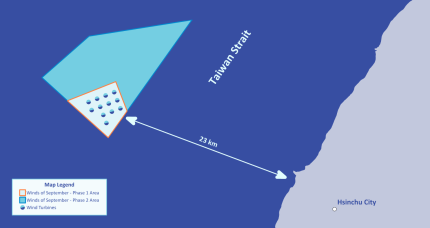
BlueFloat Energy has revealed the location for the site of its ‘Winds of September Phase 1’ project to participate in the upcoming floating Demonstration programme, due to be launched by the Taiwanese government later this year. A collaboration agreement between BlueFloat Energy and the Metal Industries Research & Development Centre (MIRDC) for ‘The Capacity Analysis of Taiwan Local Manufacturing Supply Chain for Floating Offshore Wind Mooring and Anchoring Systems’ has been signed, reaffirming BlueFloat Energy’s commitment to delivering the first floating offshore wind farm in Taiwan.
The Winds of September Phase 1 project, in development since 2021, will involve the installation of up to 12 floating platforms for an expected capacity of 180 MW. The site is located approximately 23 km offshore from Hsinchu City. A thorough Energy Yield Assessment has been conducted following its launch in March 2023.
Together with a comprehensive Environmental and Social Impact Assessment (ESIA) process and geophysical surveys to assess key environmental constraints and soil conditions, these efforts have guided the selection and layout design of the project site.
BlueFloat Energy’s approach includes both desktop studies and on-site investigations as well as on-the-ground stakeholder engagement, to ensure opportunities for co-operation with local communities.
The collaboration with MIRDC exploits the centre’s expertise in advancing Taiwan’s offshore wind supply chain, and its years of experience assisting local suppliers in overcoming challenges and aligning with international standards for constructing bottom-fixed offshore wind farms. The collaboration focuses on assessing the capabilities of the 1st and 2nd tiers of Taiwanese suppliers in key packages of floating foundations particularly.
The project’s collaboration with the MIRDC is intended also to serve as a foundation for the Winds of September – Phase 2 as a potential participant in Zonal Development R3-3 bidding. The ultimate goal is to accomplish large-scale commercial development of floating technology in Taiwan in order to achieve the country’s offshore wind installation targets for 2035, as the potential for bottom-fixed projects is nearly exhausted.






